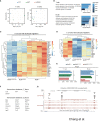Impaired tissue homing by the Ikzf3N159S variant is mediated by interfering with Ikaros function
- PMID: 37662955
- PMCID: PMC10469740
- DOI: 10.3389/fimmu.2023.1239779
Impaired tissue homing by the Ikzf3N159S variant is mediated by interfering with Ikaros function
Abstract
AIOLOS, encoded by IKZF3, is a member of the IKZF family of proteins that plays an important role in regulating late B-cell differentiation. Human individuals heterozygous for the AIOLOS p.N160S variant displayed impaired humoral immune responses as well as impaired B and T cell development. We have previously reported that a mouse strain harboring an Ikzf3N159S allele that corresponds to human IKZF3N160S recapitulated immune-deficient phenotypes, such as impaired B cell development and loss of CD23 expression. In this study, we investigated the effect of the Ikzf3N159S variant and found that B1a cell development was impaired in Ikzf3N159S/N159S mice. In addition, CD62L expression was severely decreased in both B and T lymphocytes by the Ikzf3N159S mutation, in a dose-dependent manner. Mixed bone marrow chimera experiments have revealed that most immunodeficient phenotypes, including low CD62L expression, occur in intrinsic cells. Interestingly, while Ikzf3N159S/N159S lymphocytes were still present in the spleen, they were completely outcompeted by control cells in the lymph nodes, suggesting that the capacity for homing or retention in the lymph nodes was lost due to the Ikzf3N159S mutation. The homing assay confirmed severely decreased homing abilities to lymph nodes of Ikzf3N159S/N159S B and T lymphocytes but selective enrichment of CD62L expressing Ikzf3N159S/N159S lymphocytes in lymph nodes. This finding suggests that impaired CD62L expression is the major reason for the impaired homing capacity caused by the Ikzf3N159S mutation. Interestingly, an excess amount of Ikaros, but not Aiolos, restored CD62L expression in Ikzf3N159S/N159S B cells. Together with the loss of CD62L expression due to Ikaros deficiency, the AiolosN159S mutant protein likely interferes with Ikaros function through heterodimerization, at least in activating the Sell gene encoding CD62L expression. Thus, our results revealed that AiolosN159S causes some immunodeficient phenotypes via the pathogenesis referred to as the heterodimeric interference as observed for AiolosG158R variant.
Keywords: CD62L; IKZF family proteins; heterodimeric interference; immune deficiency; lymphocyte homing.
Copyright © 2023 Chang, Yamashita, Padhi, Zhang and Taniuchi.
Conflict of interest statement
The authors declare that the research was conducted in the absence of any commercial or financial relationships that could be construed as a potential conflict of interest.
Figures







Similar articles
-
AIOLOS-Associated Inborn Errors of Immunity.J Clin Immunol. 2024 May 22;44(6):128. doi: 10.1007/s10875-024-01730-9. J Clin Immunol. 2024. PMID: 38773004 Free PMC article. Review.
-
AIOLOS Variants Causing Immunodeficiency in Human and Mice.Front Immunol. 2022 Apr 4;13:866582. doi: 10.3389/fimmu.2022.866582. eCollection 2022. Front Immunol. 2022. PMID: 35444653 Free PMC article. Review.
-
A variant in human AIOLOS impairs adaptive immunity by interfering with IKAROS.Nat Immunol. 2021 Jul;22(7):893-903. doi: 10.1038/s41590-021-00951-z. Epub 2021 Jun 21. Nat Immunol. 2021. PMID: 34155405 Free PMC article.
-
T and B cell abnormalities, pneumocystis pneumonia, and chronic lymphocytic leukemia associated with an AIOLOS defect in patients.J Exp Med. 2021 Dec 6;218(12):e20211118. doi: 10.1084/jem.20211118. Epub 2021 Oct 25. J Exp Med. 2021. PMID: 34694366 Free PMC article.
-
Identification and Functional Analysis of a de novo IKZF3 Mutation in a Pediatric Patient with Combined Immunodeficiency.J Clin Immunol. 2024 May 17;44(5):117. doi: 10.1007/s10875-024-01706-9. J Clin Immunol. 2024. PMID: 38758229
Cited by
-
A Rare AIOLOS N160S Variant Causing IEI in Human.J Clin Immunol. 2024 Feb 1;44(2):57. doi: 10.1007/s10875-024-01657-1. J Clin Immunol. 2024. PMID: 38296893 No abstract available.
-
AIOLOS-Associated Inborn Errors of Immunity.J Clin Immunol. 2024 May 22;44(6):128. doi: 10.1007/s10875-024-01730-9. J Clin Immunol. 2024. PMID: 38773004 Free PMC article. Review.
-
Aiolos promotes CXCR3 expression on Th1 cells via positive regulation of IFN-γ/STAT1 signaling.JCI Insight. 2024 Nov 19;10(1):e180287. doi: 10.1172/jci.insight.180287. JCI Insight. 2024. PMID: 39560988 Free PMC article.
References
-
- Tangye SG, Al-Herz W, Bousfiha A, Cunningham-Rundles C, Franco JL, Holland SM, et al. Human inborn errors of immunity: 2022 update on the classification from the international union of immunological societies expert committee. J Clin Immunol (2022) 42(7):1473–507. doi: 10.1007/s10875-022-01289-3 - DOI - PMC - PubMed
Publication types
MeSH terms
Substances
LinkOut - more resources
Full Text Sources
Molecular Biology Databases
Research Materials
Miscellaneous

